Welcome to the multiplication facts worksheets page at Math-Drills.com! On this page, you will find Multiplication worksheets for practicing multiplication facts at various levels and in a variety of formats. This is our most popular page due to the wide variety of worksheets for multiplication available. Or it could be that learning multiplication facts and multiplication strategies are essential to many topics in mathematics beyond third grade math.
Learning multiplication facts to the point of quick recall should be a goal for all students and will serve them well in their math studies. Multiplication facts are actually easier to learn than you might think. First of all, it is only essential to learn the facts from 1 to 9. Somewhere along the way students can learn that anything multiplied by zero is zero. Hopefully, that is an easy one. Students also need to learn to multiply by ten as a precursor to learning how to multiply other powers of ten. After those three skills are learned, everything else is long multiplication. Multiplying by 11 is actually two-digit multiplication. Now, learning fact tables of 11 and beyond will do no harm to those students who are keen and able to learn these things quickly, and it might help them figure out how many eggs are in a gross faster than anyone else, but keep it simple for those students who struggle a bit more.
Most Popular Multiplication Facts Worksheets this Week





Multiplication Facts Tables
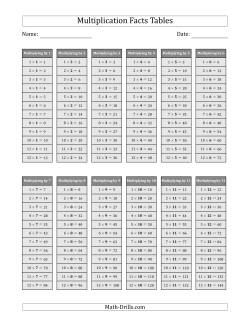
The multiplication tables with individual questions include a separate box for each number. In each box, the single number is multiplied by every other number with each question on one line. The tables may be used for various purposes such as introducing the multiplication tables, skip counting, as a lookup table, patterning activities, and memorizing.
-
Multiplication Facts Tables in Gray 1 to 12 Multiplication Facts Tables in Gray 1 to 12 (Answers Omitted) Multiplication Facts Tables in Color 1 to 12 Multiplication Facts Tables in Color 1 to 12 (Answers Omitted) Multiplication Facts Tables in Montessori Colors 1 to 12 Multiplication Facts Tables in Montessori Colors 1 to 12 (Answers Omitted)
-
Multiplication Facts Tables in Gray 0 to 11 Multiplication Facts Tables in Gray 0 to 11 (Answers Omitted) Multiplication Facts Tables in Color 0 to 11 Multiplication Facts Tables in Color 0 to 11 (Answers Omitted) Multiplication Facts Tables in Montessori Colors 0 to 11 Multiplication Facts Tables in Montessori Colors 0 to 11 (Answers Omitted)
The compact multiplication tables are basically lookup charts. To look up a multiplication fact, find the first factor in the column header and the second factor in the row headers; then use straight edges, your fingers or your eyes to find where the column and row intersect to get the product. These tables are better than the previous tables for finding patterns, but they can be used in similar ways. Each PDF includes a filled out table page and a blank table page. The blank tables can be used for practice or assessment. You might also make a game out of it, such as "Pin the Fact on the Table" (a play on Pin the Tail on the Donkey). Students are given a product (answer) and they pin it on an enlarged version or the table (photocopier enlargement, interactive whiteboard, overhead projector, etc.). Paper-saving versions with multiple tables per page are included. The left-handed versions of the multiplication tables recognize that students who use their left hands might block the row headings on the right-handed versions.
Five Minute Multiplication Frenzies
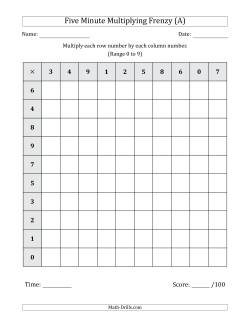
Five minute frenzy charts are 10 by 10 grids that are used for multiplication fact practice (up to 12 x 12) and improving recall speed. They are very much like compact multiplication tables, but all the numbers are mixed up, so students are unable to use skip counting to fill them out. In each square, students write the product of the column number and the row number. They try to complete the chart in a set time with an accuracy goal (such as less than five minutes and score 98 percent or better).
It is important to note here that you should NOT have students complete five minute frenzies if they don't already know all of the multiplication facts that appear on them. If you want them to participate with the rest of the class, cross off the rows and columns that they don't know and have them complete a modified version. Remember, these charts are for practice and improving recall, not a teaching tool by itself.
Students who write with their left hands may cover the row headings on the right-handed versions, so the left-handed versions have the row headings on the other side.
Multiplication Facts up to the 7 Times Table
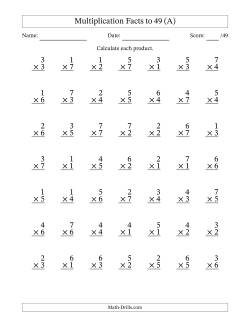
This section includes math worksheets for practicing multiplication facts to from 0 to 49. There are two worksheets in this section that include all of the possible questions exactly once on each page: the 49 question worksheet with no zeros and the 64 question worksheet with zeros. All others either contain all the possible questions plus some repeats or a unique subset of the possible questions.
When a student first learns multiplication facts, try not to overwhelm them with the entire multiplication table. The following worksheets include one row of the facts in order with the target digit on the bottom and one row with the target digit on the top. The remaining rows include each of the facts once, but the target digit is randomly placed on the top or the bottom and the facts are randomly mixed on each row.
-
Horizontally Arranged Multiplying (1 to 7) by 1 (100 Questions) ✎ Horizontally Arranged Multiplying (1 to 7) by 2 (100 Questions) ✎ Horizontally Arranged Multiplying (1 to 7) by 3 (100 Questions) ✎ Horizontally Arranged Multiplying (1 to 7) by 4 (100 Questions) ✎ Horizontally Arranged Multiplying (1 to 7) by 5 (100 Questions) ✎ Horizontally Arranged Multiplying (1 to 7) by 6 (100 Questions) ✎ Horizontally Arranged Multiplying (1 to 7) by 7 (100 Questions) ✎
-
Horizontally Arranged Multiplying (1 to 7) by 1 (50 Questions) ✎ Horizontally Arranged Multiplying (1 to 7) by 2 (50 Questions) ✎ Horizontally Arranged Multiplying (1 to 7) by 3 (50 Questions) ✎ Horizontally Arranged Multiplying (1 to 7) by 4 (50 Questions) ✎ Horizontally Arranged Multiplying (1 to 7) by 5 (50 Questions) ✎ Horizontally Arranged Multiplying (1 to 7) by 6 (50 Questions) ✎ Horizontally Arranged Multiplying (1 to 7) by 7 (50 Questions) ✎
-
Horizontally Arranged Multiplying (1 to 7) by 1 (25 Questions; Large Print) ✎ Horizontally Arranged Multiplying (1 to 7) by 2 (25 Questions; Large Print) ✎ Horizontally Arranged Multiplying (1 to 7) by 3 (25 Questions; Large Print) ✎ Horizontally Arranged Multiplying (1 to 7) by 4 (25 Questions; Large Print) ✎ Horizontally Arranged Multiplying (1 to 7) by 5 (25 Questions; Large Print) ✎ Horizontally Arranged Multiplying (1 to 7) by 6 (25 Questions; Large Print) ✎ Horizontally Arranged Multiplying (1 to 7) by 7 (25 Questions; Large Print) ✎
Multiplication Facts up to the 9 Times Table
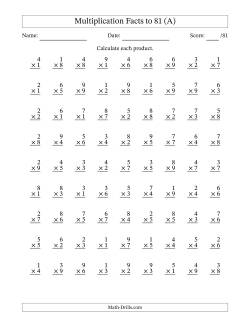
This section includes math worksheets for practicing multiplication facts from 0 to 81. There are three worksheets (marked with *) in this section that include all of the possible questions in the specified range exactly once on each page: the 64 question worksheet with no zeros or ones, the 81 question worksheet with no zeros, and the 100 question worksheet with zeros. All others either contain all the possible questions plus some repeats or a unique subset of the possible questions.
-
Multiplication Facts to 81 (100 Questions) (No Zeros or Ones) ✎ Multiplication Facts to 81 (81 Questions) (No Zeros or Ones) ✎ *Multiplication Facts to 81 (64 Questions) (No Zeros or Ones) ✎ Multiplication Facts to 81 (50 Questions) (No Zeros or Ones) ✎ Multiplication Facts to 81 (25 Questions) (No Zeros or Ones) ✎
When learning multiplication facts, it is useful to have each fact isolated on a set of practice questions to help reinforce the individual fact. The following worksheets isolate each fact. These worksheets can be used as practice sheets, assessment sheets, or in conjunction with another teaching strategy such as manipulative use.
-
Multiplying (1 to 9) by 0 (81 Questions) ✎ Multiplying (1 to 9) by 1 (81 Questions) ✎ Multiplying (1 to 9) by 2 (81 Questions) ✎ Multiplying (1 to 9) by 3 (81 Questions) ✎ Multiplying (1 to 9) by 4 (81 Questions) ✎ Multiplying (1 to 9) by 5 (81 Questions) ✎ Multiplying (1 to 9) by 6 (81 Questions) ✎ Multiplying (1 to 9) by 7 (81 Questions) ✎ Multiplying (1 to 9) by 8 (81 Questions) ✎ Multiplying (1 to 9) by 9 (81 Questions) ✎ Multiplying (1 to 9) by (3 and 4) (81 Questions) ✎ Multiplying (1 to 9) by (4 and 5) (81 Questions) ✎ Multiplying (1 to 9) by (5 and 6) (81 Questions) ✎ Multiplying (1 to 9) by (6 and 7) (81 Questions) ✎ Multiplying (1 to 9) by (7 and 8) (81 Questions) ✎ Multiplying (1 to 9) by (8 and 9) (81 Questions) ✎ Multiplying (1 to 9) by (6 to 8) (81 Questions) ✎ Multiplying (1 to 9) by (7 to 9) (81 Questions) ✎ Multiplying (1 to 9) by (6 to 9) (81 Questions) ✎
-
Multiplying (1 to 9) by 0 (36 Questions) ✎ Multiplying (1 to 9) by 1 (36 Questions) ✎ Multiplying (1 to 9) by 2 (36 Questions) ✎ Multiplying (1 to 9) by 3 (36 Questions) ✎ Multiplying (1 to 9) by 4 (36 Questions) ✎ Multiplying (1 to 9) by 5 (36 Questions) ✎ Multiplying (1 to 9) by 6 (36 Questions) ✎ Multiplying (1 to 9) by 7 (36 Questions) ✎ Multiplying (1 to 9) by 8 (36 Questions) ✎ Multiplying (1 to 9) by 9 (36 Questions) ✎ Multiplying (1 to 9) by (6 and 7) (36 Questions) ✎ Multiplying (1 to 9) by (7 and 8) (36 Questions) ✎ Multiplying (1 to 9) by (8 and 9) (36 Questions) ✎ Multiplying (1 to 9) by (6 to 8) (36 Questions) ✎ Multiplying (1 to 9) by (7 to 9) (36 Questions) ✎ Multiplying (1 to 9) by (6 to 9) (36 Questions) ✎
-
Horizontally Arranged Multiplying (0 to 9) by 0 (100 Questions) ✎ Horizontally Arranged Multiplying (0 to 9) by 1 (100 Questions) ✎ Horizontally Arranged Multiplying (0 to 9) by 2 (100 Questions) ✎ Horizontally Arranged Multiplying (0 to 9) by 3 (100 Questions) ✎ Horizontally Arranged Multiplying (0 to 9) by 4 (100 Questions) ✎ Horizontally Arranged Multiplying (0 to 9) by 5 (100 Questions) ✎ Horizontally Arranged Multiplying (0 to 9) by 6 (100 Questions) ✎ Horizontally Arranged Multiplying (0 to 9) by 7 (100 Questions) ✎ Horizontally Arranged Multiplying (0 to 9) by 8 (100 Questions) ✎ Horizontally Arranged Multiplying (0 to 9) by 9 (100 Questions) ✎
-
Horizontally Arranged Multiplying (0 to 9) by 0 (50 Questions) ✎ Horizontally Arranged Multiplying (0 to 9) by 1 (50 Questions) ✎ Horizontally Arranged Multiplying (0 to 9) by 2 (50 Questions) ✎ Horizontally Arranged Multiplying (0 to 9) by 3 (50 Questions) ✎ Horizontally Arranged Multiplying (0 to 9) by 4 (50 Questions) ✎ Horizontally Arranged Multiplying (0 to 9) by 5 (50 Questions) ✎ Horizontally Arranged Multiplying (0 to 9) by 6 (50 Questions) ✎ Horizontally Arranged Multiplying (0 to 9) by 7 (50 Questions) ✎ Horizontally Arranged Multiplying (0 to 9) by 8 (50 Questions) ✎ Horizontally Arranged Multiplying (0 to 9) by 9 (50 Questions) ✎
-
Horizontally Arranged Multiplying (0 to 9) by 0 (25 Questions; Large Print) ✎ Horizontally Arranged Multiplying (0 to 9) by 1 (25 Questions; Large Print) ✎ Horizontally Arranged Multiplying (0 to 9) by 2 (25 Questions; Large Print) ✎ Horizontally Arranged Multiplying (0 to 9) by 3 (25 Questions; Large Print) ✎ Horizontally Arranged Multiplying (0 to 9) by 4 (25 Questions; Large Print) ✎ Horizontally Arranged Multiplying (0 to 9) by 5 (25 Questions; Large Print) ✎ Horizontally Arranged Multiplying (0 to 9) by 6 (25 Questions; Large Print) ✎ Horizontally Arranged Multiplying (0 to 9) by 7 (25 Questions; Large Print) ✎ Horizontally Arranged Multiplying (0 to 9) by 8 (25 Questions; Large Print) ✎ Horizontally Arranged Multiplying (0 to 9) by 9 (25 Questions; Large Print) ✎
Some students are a little more motivated when learning is turned into a game. Multiplication bingo encourages students to recall multiplication facts in an environment of competition.
Multiplication Facts up to the 10 Times Table
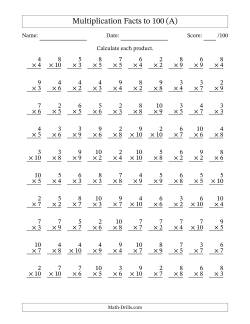
Multiplying by 10 is often a lesson itself, but here we have included it with the other facts. Students usually learn how to multiply by 10 fairly quickly, so this section really is not a whole lot more difficult than the multiplication facts to 81 section.
Some students find it easier to focus on one multiplication fact at a time. These multiplication worksheets include some repetition, of course, as there is only one thing to multiply by. Once students practice a few times, these facts will probably get stuck in their heads for life. Some of the later versions include a range of focus numbers. In those cases, each question will randomly have one of the focus numbers in question. For example, if the range is 6 to 8, the question might include a 6, 7 or 8 or more than one depending on which other factor was chosen for the second factor.
-
Multiplying (1 to 10) by 0 (100 Questions) ✎ Multiplying (1 to 10) by 1 (100 Questions) ✎ Multiplying (1 to 10) by 2 (100 Questions) ✎ Multiplying (1 to 10) by 3 (100 Questions) ✎ Multiplying (1 to 10) by 4 (100 Questions) ✎ Multiplying (1 to 10) by 5 (100 Questions) ✎ Multiplying (1 to 10) by 6 (100 Questions) ✎ Multiplying (1 to 10) by 7 (100 Questions) ✎ Multiplying (1 to 10) by 8 (100 Questions) ✎ Multiplying (1 to 10) by 9 (100 Questions) ✎ Multiplying (1 to 10) by 10 (100 Questions) ✎
-
Multiplying (1 to 10) by (6 and 7) (100 Questions) ✎ Multiplying (1 to 10) by (7 and 8) (100 Questions) ✎ Multiplying (1 to 10) by (8 and 9) (100 Questions) ✎ Multiplying (1 to 10) by (9 and 10) (100 Questions) ✎ Multiplying (1 to 10) by (6 to 8) (100 Questions) ✎ Multiplying (1 to 10) by (7 to 9) (100 Questions) ✎ Multiplying (1 to 10) by (8 to 10) (100 Questions) ✎ Multiplying Doubles (aka Squares) from (1 to 10) (100 Questions)
-
Multiplying (1 to 10) by 0 (50 Questions) ✎ Multiplying (1 to 10) by 1 (50 Questions) ✎ Multiplying (1 to 10) by 2 (50 Questions) ✎ Multiplying (1 to 10) by 3 (50 Questions) ✎ Multiplying (1 to 10) by 4 (50 Questions) ✎ Multiplying (1 to 10) by 5 (50 Questions) ✎ Multiplying (1 to 10) by 6 (50 Questions) ✎ Multiplying (1 to 10) by 7 (50 Questions) ✎ Multiplying (1 to 10) by 8 (50 Questions) ✎ Multiplying (1 to 10) by 9 (50 Questions) ✎ Multiplying (1 to 10) by 10 (50 Questions) ✎
-
Multiplying (1 to 10) by (6 and 7) (50 Questions) ✎ Multiplying (1 to 10) by (7 and 8) (50 Questions) ✎ Multiplying (1 to 10) by (8 and 9) (50 Questions) ✎ Multiplying (1 to 10) by (9 and 10) (50 Questions) ✎ Multiplying (1 to 10) by (6 to 8) (50 Questions) ✎ Multiplying (1 to 10) by (7 to 9) (50 Questions) ✎ Multiplying (1 to 10) by (8 to 10) (50 Questions) ✎
-
Multiplying (1 to 10) by 0 (36 Questions) ✎ Multiplying (1 to 10) by 1 (36 Questions) ✎ Multiplying (1 to 10) by 2 (36 Questions) ✎ Multiplying (1 to 10) by 3 (36 Questions) ✎ Multiplying (1 to 10) by 4 (36 Questions) ✎ Multiplying (1 to 10) by 5 (36 Questions) ✎ Multiplying (1 to 10) by 6 (36 Questions) ✎ Multiplying (1 to 10) by 7 (36 Questions) ✎ Multiplying (1 to 10) by 8 (36 Questions) ✎ Multiplying (1 to 10) by 9 (36 Questions) ✎ Multiplying (1 to 10) by 10 (36 Questions) ✎
-
Multiplying (1 to 10) by (6 and 7) (42 Questions) ✎ Multiplying (1 to 10) by (7 and 8) (42 Questions) ✎ Multiplying (1 to 10) by (8 and 9) (42 Questions) ✎ Multiplying (1 to 10) by (9 and 10) (42 Questions) ✎ Multiplying (1 to 10) by (6 to 8) (42 Questions) ✎ Multiplying (1 to 10) by (7 to 9) (42 Questions) ✎ Multiplying (1 to 10) by (8 to 10) (42 Questions) ✎
-
Horizontally Arranged Multiplying (1 to 10) by 1 (100 Questions) ✎ Horizontally Arranged Multiplying (1 to 10) by 2 (100 Questions) ✎ Horizontally Arranged Multiplying (1 to 10) by 3 (100 Questions) ✎ Horizontally Arranged Multiplying (1 to 10) by 4 (100 Questions) ✎ Horizontally Arranged Multiplying (1 to 10) by 5 (100 Questions) ✎ Horizontally Arranged Multiplying (1 to 10) by 6 (100 Questions) ✎ Horizontally Arranged Multiplying (1 to 10) by 7 (100 Questions) ✎ Horizontally Arranged Multiplying (1 to 10) by 8 (100 Questions) ✎ Horizontally Arranged Multiplying (1 to 10) by 9 (100 Questions) ✎ Horizontally Arranged Multiplying (1 to 10) by 10 (100 Questions) ✎
-
Horizontally Arranged Multiplying (1 to 10) by 1 (50 Questions) ✎ Horizontally Arranged Multiplying (1 to 10) by 2 (50 Questions) ✎ Horizontally Arranged Multiplying (1 to 10) by 3 (50 Questions) ✎ Horizontally Arranged Multiplying (1 to 10) by 4 (50 Questions) ✎ Horizontally Arranged Multiplying (1 to 10) by 5 (50 Questions) ✎ Horizontally Arranged Multiplying (1 to 10) by 6 (50 Questions) ✎ Horizontally Arranged Multiplying (1 to 10) by 7 (50 Questions) ✎ Horizontally Arranged Multiplying (1 to 10) by 8 (50 Questions) ✎ Horizontally Arranged Multiplying (1 to 10) by 9 (50 Questions) ✎ Horizontally Arranged Multiplying (1 to 10) by 10 (50 Questions) ✎
-
Horizontally Arranged Multiplying (1 to 10) by 1 (25 Questions; Large Print) ✎ Horizontally Arranged Multiplying (1 to 10) by 2 (25 Questions; Large Print) ✎ Horizontally Arranged Multiplying (1 to 10) by 3 (25 Questions; Large Print) ✎ Horizontally Arranged Multiplying (1 to 10) by 4 (25 Questions; Large Print) ✎ Horizontally Arranged Multiplying (1 to 10) by 5 (25 Questions; Large Print) ✎ Horizontally Arranged Multiplying (1 to 10) by 6 (25 Questions; Large Print) ✎ Horizontally Arranged Multiplying (1 to 10) by 7 (25 Questions; Large Print) ✎ Horizontally Arranged Multiplying (1 to 10) by 8 (25 Questions; Large Print) ✎ Horizontally Arranged Multiplying (1 to 10) by 9 (25 Questions; Large Print) ✎ Horizontally Arranged Multiplying (1 to 10) by 10 (25 Questions; Large Print) ✎
If a student is learning their times tables one at a time, these worksheets will help with practice and assessment along the way. Each one increases the range for the second factor.
-
Multiplying (1 to 10) by (1 and 2) (100 Questions) ✎ Multiplying (1 to 10) by (1 to 3) (100 Questions) ✎ Multiplying (1 to 10) by (1 to 4) (100 Questions) ✎ Multiplying (1 to 10) by (1 to 5) (100 Questions) ✎ Multiplying (1 to 10) by (1 to 6) (100 Questions) ✎ Multiplying (1 to 10) by (1 to 7) (100 Questions) ✎ Multiplying (1 to 10) by (1 to 8) (100 Questions) ✎ Multiplying (1 to 10) by (1 to 9) (100 Questions) ✎
-
Multiplying (1 to 10) by (1 and 2) (50 Questions) ✎ Multiplying (1 to 10) by (1 to 3) (50 Questions) ✎ Multiplying (1 to 10) by (1 to 4) (50 Questions) ✎ Multiplying (1 to 10) by (1 to 5) (50 Questions) ✎ Multiplying (1 to 10) by (1 to 6) (50 Questions) ✎ Multiplying (1 to 10) by (1 to 7) (50 Questions) ✎ Multiplying (1 to 10) by (1 to 8) (50 Questions) ✎ Multiplying (1 to 10) by (1 to 9) (50 Questions) ✎
Multiplication Facts up to the 12 Times Table
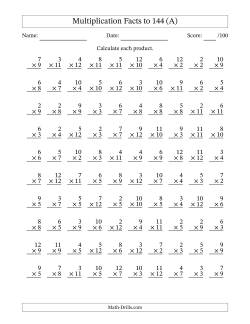
The Holy Grail of elementary mathematics. Once you learn your twelve times table, it is smooth sailing from now on, right? Well, not exactly, but having a good mental recall of the multiplication facts up to 144 will certainly set you on the right path for future success in your math studies.
With one, two or three target numbers at a time, students are able to practice just the multiplication facts they need.
-
Multiplying (1 to 12) By 0 (100 Questions) ✎ Multiplying (1 to 12) By 1 (100 Questions) ✎ Multiplying (1 to 12) By 2 (100 Questions) ✎ Multiplying (1 to 12) By 3 (100 Questions) ✎ Multiplying (1 to 12) By 4 (100 Questions) ✎ Multiplying (1 to 12) By 5 (100 Questions) ✎ Multiplying (1 to 12) By 6 (100 Questions) ✎ Multiplying (1 to 12) By 7 (100 Questions) ✎ Multiplying (1 to 12) By 8 (100 Questions) ✎ Multiplying (1 to 12) By 9 (100 Questions) ✎ Multiplying (1 to 12) By 10 (100 Questions) ✎ Multiplying (1 to 12) By 11 (100 Questions) ✎ Multiplying (1 to 12) By 12 (100 Questions) ✎
-
Multiplying (1 to 12) By (0 and 1) (100 Questions) ✎ Multiplying (1 to 12) By (6 and 7) (100 Questions) Multiplying (1 to 12) By (7 and 8) (100 Questions) ✎ Multiplying (1 to 12) By (8 and 9) (100 Questions) ✎ Multiplying (1 to 12) By (9 and 10) (100 Questions) ✎ Multiplying (1 to 12) By (10 and 11) (100 Questions) ✎ Multiplying (1 to 12) By (11 and 12) (100 Questions) ✎ Multiplying (1 to 12) By (6, 7 and 8) (100 Questions) ✎ Multiplying (1 to 12) By (7, 8 and 9) (100 Questions) ✎ Multiplying (1 to 12) By (8, 9 and 10) (100 Questions) ✎ Multiplying (1 to 12) By (9, 10 and 11) (100 Questions) ✎ Multiplying (1 to 12) By (10, 11 and 12) (100 Questions) ✎
-
Multiplying (1 to 12) By 0 (50 Questions) ✎ Multiplying (1 to 12) By 1 (50 Questions) ✎ Multiplying (1 to 12) By 2 (50 Questions) ✎ Multiplying (1 to 12) By 3 (50 Questions) ✎ Multiplying (1 to 12) By 4 (50 Questions) ✎ Multiplying (1 to 12) By 5 (50 Questions) ✎ Multiplying (1 to 12) By 6 (50 Questions) ✎ Multiplying (1 to 12) By 7 (50 Questions) ✎ Multiplying (1 to 12) By 8 (50 Questions) ✎ Multiplying (1 to 12) By 9 (50 Questions) ✎ Multiplying (1 to 12) By 10 (50 Questions) ✎ Multiplying (1 to 12) By 11 (50 Questions) ✎ Multiplying (1 to 12) By 12 (50 Questions) ✎
-
Multiplying (1 to 12) By (6 and 7) (50 Questions) ✎ Multiplying (1 to 12) By (7 and 8) (50 Questions) ✎ Multiplying (1 to 12) By (8 and 9) (50 Questions) ✎ Multiplying (1 to 12) By (9 and 10) (50 Questions) ✎ Multiplying (1 to 12) By (10 and 11) (50 Questions) ✎ Multiplying (1 to 12) By (11 and 12) (50 Questions) ✎ Multiplying (1 to 12) By (6, 7 and 8) (50 Questions) ✎ Multiplying (1 to 12) By (7, 8 and 9) (50 Questions) ✎ Multiplying (1 to 12) By (8, 9 and 10) (50 Questions) ✎ Multiplying (1 to 12) By (9, 10 and 11) (50 Questions) ✎ Multiplying (1 to 12) By (10, 11 and 12) (50 Questions) ✎
-
Horizontally Arranged Multiplying (0 to 12) by 0 (100 Questions) ✎ Horizontally Arranged Multiplying (0 to 12) by 1 (100 Questions) ✎ Horizontally Arranged Multiplying (0 to 12) by 2 (100 Questions) ✎ Horizontally Arranged Multiplying (0 to 12) by 3 (100 Questions) ✎ Horizontally Arranged Multiplying (0 to 12) by 4 (100 Questions) ✎ Horizontally Arranged Multiplying (0 to 12) by 5 (100 Questions) ✎ Horizontally Arranged Multiplying (0 to 12) by 6 (100 Questions) ✎ Horizontally Arranged Multiplying (0 to 12) by 7 (100 Questions) ✎ Horizontally Arranged Multiplying (0 to 12) by 8 (100 Questions) ✎ Horizontally Arranged Multiplying (0 to 12) by 9 (100 Questions) ✎ Horizontally Arranged Multiplying (0 to 12) by 10 (100 Questions) ✎ Horizontally Arranged Multiplying (0 to 12) by 11 (100 Questions) ✎ Horizontally Arranged Multiplying (0 to 12) by 12 (100 Questions) ✎
-
Horizontally Arranged Multiplying (0 to 12) by 0 (50 Questions) ✎ Horizontally Arranged Multiplying (0 to 12) by 1 (50 Questions) ✎ Horizontally Arranged Multiplying (0 to 12) by 2 (50 Questions) ✎ Horizontally Arranged Multiplying (0 to 12) by 3 (50 Questions) ✎ Horizontally Arranged Multiplying (0 to 12) by 4 (50 Questions) ✎ Horizontally Arranged Multiplying (0 to 12) by 5 (50 Questions) ✎ Horizontally Arranged Multiplying (0 to 12) by 6 (50 Questions) ✎ Horizontally Arranged Multiplying (0 to 12) by 7 (50 Questions) ✎ Horizontally Arranged Multiplying (0 to 12) by 8 (50 Questions) ✎ Horizontally Arranged Multiplying (0 to 12) by 9 (50 Questions) ✎ Horizontally Arranged Multiplying (0 to 12) by 10 (50 Questions) ✎ Horizontally Arranged Multiplying (0 to 12) by 11 (50 Questions) ✎ Horizontally Arranged Multiplying (0 to 12) by 12 (50 Questions) ✎
-
Horizontally Arranged Multiplying (0 to 12) by 0 (25 Questions; Large Print) ✎ Horizontally Arranged Multiplying (0 to 12) by 1 (25 Questions; Large Print) ✎ Horizontally Arranged Multiplying (0 to 12) by 2 (25 Questions; Large Print) ✎ Horizontally Arranged Multiplying (0 to 12) by 3 (25 Questions; Large Print) ✎ Horizontally Arranged Multiplying (0 to 12) by 4 (25 Questions; Large Print) ✎ Horizontally Arranged Multiplying (0 to 12) by 5 (25 Questions; Large Print) ✎ Horizontally Arranged Multiplying (0 to 12) by 6 (25 Questions; Large Print) ✎ Horizontally Arranged Multiplying (0 to 12) by 7 (25 Questions; Large Print) ✎ Horizontally Arranged Multiplying (0 to 12) by 8 (25 Questions; Large Print) ✎ Horizontally Arranged Multiplying (0 to 12) by 9 (25 Questions; Large Print) ✎ Horizontally Arranged Multiplying (0 to 12) by 10 (25 Questions; Large Print) ✎ Horizontally Arranged Multiplying (0 to 12) by 11 (25 Questions; Large Print) ✎ Horizontally Arranged Multiplying (0 to 12) by 12 (25 Questions; Large Print) ✎
In the following multiplication worksheets, the facts are grouped into anchor groups.
-
Multiplying (1 to 12) by (1 to 5) (100 Questions) ✎ Multiplying (1 to 12) by (1 to 6) (100 Questions) ✎ Multiplying (1 to 12) by (1 to 7) (100 Questions) ✎ Multiplying (1 to 12) by (1 to 8) (100 Questions) ✎ Multiplying (1 to 12) by (1 to 9) (100 Questions) ✎ Multiplying (1 to 12) by (1 to 10) (100 Questions) ✎ Multiplying (1 to 12) by (1 to 11) (100 Questions) ✎
-
Multiplying (1 to 12) by (1 to 5) (50 Questions) ✎ Multiplying (1 to 12) by (1 to 6) (50 Questions) ✎ Multiplying (1 to 12) by (1 to 7) (50 Questions) ✎ Multiplying (1 to 12) by (1 to 8) (50 Questions) ✎ Multiplying (1 to 12) by (1 to 9) (50 Questions) ✎ Multiplying (1 to 12) by (1 to 10) (50 Questions) ✎ Multiplying (1 to 12) by (1 to 11) (50 Questions) ✎
On the following multiplication worksheets, the questions are in order and might be useful for students to remember their times tables or to help them with skip counting.
-
Repetitive Multiplying of 1 by (1 to 12) Repetitive Multiplying of 2 by (1 to 12) Repetitive Multiplying of 3 by (1 to 12) Repetitive Multiplying of 4 by (1 to 12) Repetitive Multiplying of 5 by (1 to 12) Repetitive Multiplying of 6 by (1 to 12) Repetitive Multiplying of 7 by (1 to 12) Repetitive Multiplying of 8 by (1 to 12) Repetitive Multiplying of 9 by (1 to 12) Repetitive Multiplying of 10 by (1 to 12) Repetitive Multiplying of 11 by (1 to 12) Repetitive Multiplying of 12 by (1 to 12)
Multiplication Facts beyond the 12 Times Table
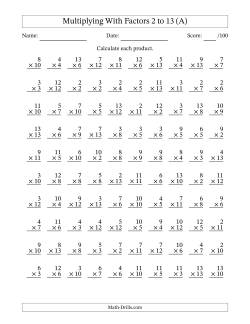
It is quite likely that there are students who have mastered all of the multiplication facts up to the 12 times tables. In case they want/need an extra challenge, this sections includes multiplication facts worksheets above 12 with the expectation that students will use mental math or recall to calculate the answers.
-
Multiplying with Factors 2 to 13 (100 Questions) ✎ Multiplying with Factors 2 to 14 (100 Questions) ✎ Multiplying with Factors 2 to 15 (100 Questions) ✎ Multiplying with Factors 5 to 15 (100 Questions) ✎ Multiplying with Factors 5 to 16 (100 Questions) ✎ Multiplying with Factors 5 to 17 (100 Questions) ✎ Multiplying with Factors 5 to 18 (100 Questions) ✎ Multiplying with Factors 5 to 19 (100 Questions) ✎ Multiplying with Factors 5 to 20 (100 Questions) ✎
-
Multiplying by 13 (49 Questions) ✎ Multiplying by 14 (49 Questions) ✎ Multiplying by 15 (49 Questions) ✎ Multiplying by 16 (49 Questions) ✎ Multiplying by 17 (49 Questions) ✎ Multiplying by 18 (49 Questions) ✎ Multiplying by 19 (49 Questions) ✎ Multiplying by 20 (49 Questions) ✎ Multiplying by 21 (49 Questions) ✎ Multiplying by 22 (49 Questions) ✎ Multiplying by 23 (49 Questions) ✎ Multiplying by 24 (49 Questions) ✎ Multiplying by 25 (49 Questions) ✎
Expand your mental math abilities by learning multiplication facts beyond the twelve times tables with these worksheets. They are horizontally arranged, so you won't be tempted to use an algorithm. Even if you can't recall all these facts yet, you can still figure them out using the distributive property. Let's say you want to multiply 19 by 19, that could be (10 × 19) + (9 × 19). Too hard? How about (10 × 10) + (10 × 9) + (9 × 10) + (9 × 9)! Or just remember that 19 × 19 = 361 :)
-
Horizontally Arranged Multiplying with Factors 1 to 13 (100 Questions) ✎ Horizontally Arranged Multiplying with Factors 1 to 14 (100 Questions) ✎ Horizontally Arranged Multiplying with Factors 1 to 15 (100 Questions) ✎ Horizontally Arranged Multiplying with Factors 2 to 16 (100 Questions) ✎ Horizontally Arranged Multiplying with Factors 2 to 17 (100 Questions) ✎ Horizontally Arranged Multiplying with Factors 2 to 18 (100 Questions) ✎ Horizontally Arranged Multiplying with Factors 2 to 19 (100 Questions) ✎ Horizontally Arranged Multiplying with Factors 2 to 20 (100 Questions) ✎ Horizontally Arranged Multiplying with Factors 5 to 21 (100 Questions) ✎ Horizontally Arranged Multiplying with Factors 5 to 22 (100 Questions) ✎ Horizontally Arranged Multiplying with Factors 5 to 23 (100 Questions) ✎ Horizontally Arranged Multiplying with Factors 5 to 24 (100 Questions) ✎ Horizontally Arranged Multiplying with Factors 5 to 25 (100 Questions) ✎
-
Horizontally Arranged Multiplying (1 to 13) by 13 (100 Questions) ✎ Horizontally Arranged Multiplying (1 to 14) by 14 (100 Questions) ✎ Horizontally Arranged Multiplying (1 to 15) by 15 (100 Questions) ✎ Horizontally Arranged Multiplying (1 to 16) by 16 (100 Questions) ✎ Horizontally Arranged Multiplying (1 to 17) by 17 (100 Questions) ✎ Horizontally Arranged Multiplying (1 to 18) by 18 (100 Questions) ✎ Horizontally Arranged Multiplying (1 to 19) by 19 (100 Questions) ✎ Horizontally Arranged Multiplying (1 to 20) by 20 (100 Questions) ✎ Horizontally Arranged Multiplying (1 to 21) by 21 (100 Questions) ✎ Horizontally Arranged Multiplying (1 to 22) by 22 (100 Questions) ✎ Horizontally Arranged Multiplying (1 to 23) by 23 (100 Questions) ✎ Horizontally Arranged Multiplying (1 to 24) by 24 (100 Questions) ✎ Horizontally Arranged Multiplying (1 to 25) by 25 (100 Questions) ✎
